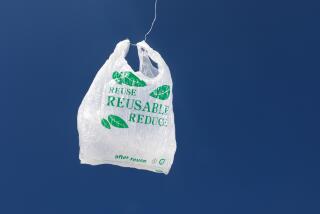HOME PURCHASES : Labels on ‘Earth-Friendly’ Products Don’t Tell the Wholesome Story
- Share via
Although government regulators and the courts are beginning to examine environmental claims seen on product packaging, some manufacturers still word their labels so your purchase will seem more earth-friendly than it really is. But common-sense sleuthing exposes most pretenders.
Here are some typical claims and sometimes-abused words:
* Recycled. Buying a product labeled recycled is good. But it is even better if the label says how much of the material is recycled. For instance, a carton could contain only 1% recycled cardboard and still make a pro-environment claim. But its impact would be worthless. Also, as you shop, favor products noting post-consumer recycled contents. This means material came from a used product, which avoided disposal in a landfill.
* Recyclable. It’s good to know that a product or package can be reused in some form. But it’s a meaningless claim unless you can, and do, recycle it. The fact that a Styrofoam cup can be recycled will do no good unless there is a nearby drop-off point for the material.
* Uses less material. These words may appear in bold letters on the package, but what do they mean? Look for a point of comparison, such as, “Uses 20% less material than our previous package.” Other vague and meaningless phrases to watch out for include “eco-friendly,” “environmentally safe” or “safe in a landfill.”
* Biodegradable. You may think you are helping the Earth by putting products labeled biodegradable in your trash. But not if the waste is headed for a landfill. Modern refuse sites entomb trash, rather than allowing it to degrade. Biodegradable is also often touted as a desirable quality for soaps and detergents. Yet almost all of these products break down on their own within 30 days.
* Ozone-friendly. Because ozone-damaging chlorofluorocarbons were removed from most products in 1978 and such destructive compounds must now be noted on package labels, there is usually no special virtue in the ozone-friendly claim.
* VOC-free. Here’s a label you could quickly learn to love. Volatile organic compounds include the smelly, noxious solvents found in many paints and finishes. Using VOC-free or reduced VOC paints and coatings is good for the environment and good for your health. However, other VOC sources abound, such as household cleaning products, floor polishes, lighter fluid and hair-styling products. Though not the primary source, these contribute to the development of ground-level ozone, better known as smog. Watch for labels indicating reduced VOCs in such products.
* Phosphate-free. Phosphates have been banned from detergents in many states. Most major detergent brands have effectively eliminated phosphates from their formulas, but check labels to be sure. Phosphates dumped into waterways endanger fish by spurring the growth of oxygen-consuming, light-blocking algae.
More to Read
Inside the business of entertainment
The Wide Shot brings you news, analysis and insights on everything from streaming wars to production — and what it all means for the future.
You may occasionally receive promotional content from the Los Angeles Times.










